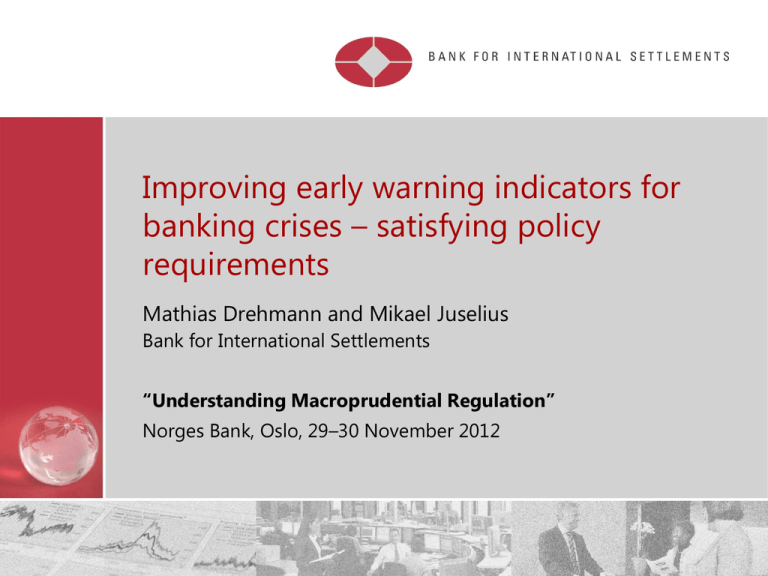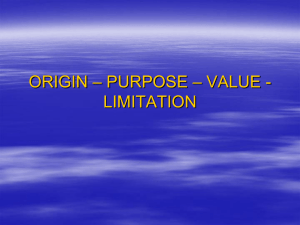Presentation - Norges Bank
advertisement

Improving early warning indicators for banking crises – satisfying policy requirements Mathias Drehmann and Mikael Juselius Bank for International Settlements “Understanding Macroprudential Regulation” Norges Bank, Oslo, 29–30 November 2012 Restricted CGFS report No 48 Operationalizing the selection and application of macroprudential instruments Restricted 2 Operationalising macroprudential policies Report focusses on 3 high-level criteria that are key in determining instrument selection and application in practice The ability to determine the appropriate timing for the activation or deactivation of the instrument The effectiveness of the MPI in achieving the stated objective The efficiency of the instrument in terms of a cost-benefit assessment Restricted 3 Report ends with 9 questions and answers 1. To what extent are vulnerabilities building up or crystallising? 2. How (un)certain is the risk assessment? 3. Is there a robust link between changes in the instrument and the stated policy objective? 4. How are expectations affected? 5. What is the scope for leakages and arbitrage? 6. How quickly and easily can an instrument be implemented? 7. What are the costs of applying a macroprudential instrument? 8. How uncertain are the effects of the policy instrument? 9. What is the optimal mix of tools to address a given vulnerability? Restricted 4 Report analysis three groups of macroprudential instruments Capital-based tools (countercyclical capital buffers, sectoral capital requirements and dynamic provisions) Liquidity-based tools (countercyclical liquidity requirements) Asset-side tools (loan-to- value (LTV) and debt-to-income (DTI) ratio caps) For all tools report proposes ‘transmission maps’ Restricted 5 Transmission map for capital based tools Voluntary buffers Loan market Leakages to nonbanks ↑ lending spreads dividend and bonuses Reprice loans credit demand Undertake SEOs1 Arbitrage away credit supply assets, especially with high RWA Expectation channel ↑ Loss Absorbency Tighter risk management Increase resilience Asset prices Impact on the credit cycle Increase capital requirements or provisions Options to address shortfall Improving early warning indicators for banking crises – satisfying policy requirements 7 Introduction CGFS (2012): Policymakers need to be able to determine the appropriate timing for the activation or deactivation of the instrument In this paper we want to find reliable early warning indicators (EWIs) for systemic banking crises What policy requirements do EWIs need to satisfy? Need to be evaluated with preference free methodology Need to have right timing Need to be stable Need to be robust Need to be understood by policymakers Restricted 8 Implementing the framework We assess a broad range of indicators We find Credit-to-GDP gap best indicator for predicting crises 2-5 years in advance Debt service ratios highly successful indicator for predicting crises 1-2 years in advance Restricted 9 How to evaluate the goodness of an EWI? To fully evaluate quality of a signal would need to know preferences of policymakers, which are unknown (eg CGFS (2012)) What are costs of acting on wrong signals (false positives)? What are the benefits of acting on correct signals (true positives)? → Need to evaluate signalling quality independent of preferences Restricted 10 The ROC curve Policymakers receive noisy signal S S higher → higher risk of a crisis At which threshold you policymakers act? 1 W1 Fully informative signal Uninformative signal Informative signal W2 1 1 W2 True positive rate True positive rate True positive rate W1 False positive rate 1 False positive rate 1 False positive rate Restricted 1 11 Area under ROC curve as measure of signalling quality Area under the ROC curve (AUROC) provides summary measure of the classification ability (eg Jorda and Taylor, 2011): AUROC 1 ROC ( FP )dFP 0 AUROC=0.5 → uninformative indicator AUROC=1 → fully informative indicator AUROC ideal measure if preferences are not known Benefits Can be estimated non-paramterically Has convenient statistical properties Restricted 12 Timing of ideal EWIs Ideal EWI needs to signal crisis early enough Likely to be 1-2 year lead-lag relationship (e.g. countercyclical capital buffers) Policymakers tend to observe trends before reacting (e.g. Bernanke, 2004) Ideal EWI signal crises not too early Introducing buffers too early may undermine effectiveness (e.g. Caruana, 2010) We look at individual quarters within a 5 year horizon Restricted 13 EWIs need to be stable and robust Policymakers adjust policy stance gradually Optimal for MP (Bernanke, 2004, Orphanides, 2003) Indictor should issue consistent signals Consistency of signal tied to persistency of underlying series (eg Park and Phillips (2000)) High degree of persistency problematic for statistical inference Non-parametric approach EWIs need to be robust to different samples and specifications Restricted 14 Interpretability of EWI Evidence that practitioners value sensibility of forecasts more than accuracy (Huss, 1987) adjust forecasts if the lack justifiable explanations (Onka-Atay et al (2009) Purely statistical approaches are not suitable for policy purposes and communication Our indicators reflect excessive leverage and asset price booms (Kindleberger, 2000, and Minsky, 1982) non-core deposits (Hahm et al, 2012) the business cycle Restricted 15 Analysing potential EWIs We construct and test a range of potential early warning indicators building on Drehmann et al (2011) We select indicator variables from... Credit measures: Credit-to-GDP gap and real credit growth Asset prices: Real property and equity price gaps and real property and equity price growth None-core bank liabilities (Hahm, Shin, and Shin (2012)): GDP growth History of financial crises ...and add one new measure: Debt service ratio (DSR) (Drehmann and Juselius (2012)): interest payments and repayments on debt divided by income Restricted 16 Analysing potential EWIs (II) We analyse quarterly time-series data from 27 countries. The sample starts in 1980 for most countries and series, and at the earliest available date for the rest Use balanced sample We follow the dating of systemic banking crises in Laeven and Valencia (2012) We ignore crises which are driven by cross-boarder exposures We adjust dating for some crisis after discussions with CBs Restricted 17 Persistency Several of the variables display dynamics which are hard to distinguish from I(2) process Indicators which have performed well in the past are more persistent → Benefits of a non-parametric approach Restricted 18 Behaviour around systemic crises Property pr. gap Equity pr. gap GDP growth -8 -4 0 4 8 12 -20 -16 -12 -4 0 4 8 10 0 -5 -20 -16 -12 -4 0 4 8 12 -20 -16 -12 Prop. price gr. -8 -4 0 4 8 12 -20 -16 -12 Equity price gr. -4 0 4 8 12 0 4 8 12 -20 -16 -12 -8 -4 0 4 8 12 -20 -16 -12 -8 -4 0 4 8 12 0 -2 0 -2 0 -1 0 -5 0 .5 0 0 0 0 1 20 10 20 50 1 .5 40 20 -8 his tory 1 00 40 Credit growth -8 -1 0 -5 0 12 60 Non-core deposit ratio -8 2 -20 -16 -12 -4 0 -5 -2 0 0 -2 0 0 0 0 5 20 50 5 20 10 40 40 1 00 Credit-to-GDP gap 15 DSR -20 -16 -12 -8 -4 0 4 8 12 -20 -16 -12 -8 -4 0 4 8 12 -20 -16 -12 -8 -4 Restricted 19 ROC curves for 2 year forecast horizon .6 .8 1 .6 .4 FP .8 1 1 .8 1 .6 RO C .4 .2 .4 0 .8 0 1 .6 .4 FP .8 1 .6 .8 1 .6 .8 1 1 .8 1 RO C .6 RO C .4 .2 .2 .4 History 0 0 .2 FP .8 1 .6 RO C .4 .2 .6 .4 Equity price gr. .2 0 .2 FP 0 0 .8 0 1 .8 1 .6 RO C .4 FP .8 Prop. price gr. .2 .6 .4 .6 .4 FP .8 1 .8 .6 RO C .4 .2 0 .2 .2 Credit growth Non-core deposi ts ratio 0 0 0 1 FP .6 .4 .4 .2 .2 0 1 FP 0 .8 .2 .4 .2 0 0 .6 .4 .6 RO C .6 RO C .6 RO C .4 .2 .2 .8 1 .8 1 .8 1 .8 .6 RO C .4 .2 0 0 GDP growth Equity pr. gap Property pr. gap Credit-to-GDP gap DSR 0 .2 .6 .4 FP .8 1 0 .2 .4 FP Restricted 20 1 1 .8 .7 .5 .6 A URO C .5 .6 A URO C .7 -15 -5 .4 .3 Property pr. gap 0 -20 -15 Equity pr. gap -5 0 -20 -15 -10 GDP growth -5 0 -20 -15 .9 -10 -5 0 -5 0 Horizon 1 1 Horizon .6 A URO C .5 A URO C .6 .7 .7 -15 -10 Horizon -5 0 -20 -15 -10 Horizon -5 0 .4 .3 .2 Prop. price gr. -20 -15 -10 Horizon Equity price gr. -5 0 -20 -15 -10 Horizon His tory .2 .2 Credit growth .2 .2 Non-core deposits ratio -20 .3 .4 .3 .4 .3 .3 .4 .4 .5 .5 .6 A URO C .7 .6 .5 .5 .6 A URO C .7 .7 .8 .8 .9 .8 .9 .8 -10 Horizon 1 Horizon 1 Horizon -10 1 -20 .2 Credit-to-GDP gap 0 .9 -5 .9 -10 .8 -15 .2 .2 DSR -20 .2 .2 .3 .3 .3 .3 .4 .4 .4 .4 .5 .6 A URO C .7 .6 .5 .5 .6 A URO C .7 .7 .8 .8 .9 .9 1 .9 1 .9 .8 .8 .9 1 ROC curves over time -5 0 -20 -15 -10 Horizon Restricted 21 Credit to GDP gap and property price gap DSR and property price gap -20 -15 Horizon -5 0 1 Credit/GDP gap -20 -15 DSR Credit\GDP gap and DSR -10 Horizon -5 DSR .2 Credit\GDP gap and prop. gap -10 .2 Property gap .3 .4 .5 .6 A UR OC .7 .8 .9 1 .9 .8 .7 .6 .5 .4 .3 .4 .5 .6 A UR OC .7 .8 .9 1 Credit to GDP gap and DSR .3 Credit/GDP gap .2 A UR OC Combining variables 0 -20 -15 Property gap DSR and prop. gap -10 -5 0 Horizon Restricted 22 Robustness checks Robust across samples Robust to different crisis dating Robust to balanced versus unbalanced samples Robust if partial ROC curves are used Restricted 23 Conclusion We argue that EWIs need satisfy six policy requirements: Need to be evaluated with preferences free methodology Need to have right timing Need to be stable Need to be robust Need to be understood by policymakers Appliying this approch to data from 27 countries we find that: The DSR and the credit-to-GDP gap dominate other EWIs The DRS dominates at shorter horizons and the credit-to-GDP gap dominates at longer ones Restricted 24








